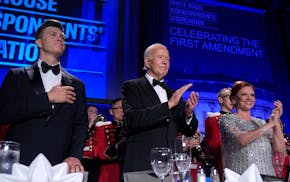Sit down on a bench and slide your hands onto neon-tinted spongy, porous silicone, and listen to a huge cat purr, as if it's sitting beneath you. In another gallery, grab packets of salty pretzels and sweet biscotti, sit down on blue leather airline seats and learn about the politics of name change.
Whichever of the 16 multimedia works by 21 regional artists in the exhibition "The Other Four" at the Weisman Art Museum that draw you in, know that none of them is trying to get you to look. Rather, they want you to touch, taste, smell or hear.
This smart show is the brainchild of curator John Schuerman. It's been in the works for more than a decade and first debuted at the Plains Art Museum in Fargo in 2019.
"I was starting to think about the sort of one-dimensionality of museums' experiences…we call it visual art for a reason," he said. "I thought it'd be interesting to do something more expansive."
In Kate Casanova's funky, fun "Sensory Seat for Porous Beings," sit on a wooden bench, lean against the wall, and put your hands on spongy soft, neon, amoeba-looking things. You'll hear clay dissolving in water or an ant colony assembling or a cat purring loudly.
"I was looking for sounds that would like activate the senses," Casanova said. "I've had cats my whole life and my cat likes to lay on my stomach and purr, and I find that to be really calming, too."
Next to it is Wendy Fernstrum's "Common Scents," a series of variously sized bottles with different colored liquids and labels on them that asks visitors to uncork bottles, take a whiff and just react. Smell is deeply personal and can take us into memory, or just to a gross- or delicious-smelling present.
From the ground to the air
Several works delve deeper into topics like colonialism, immigration and transitions.
"Fossilized Past," created by artists Nooshin Hakim, Pedram Baldari and Rodrigo Cádiz, is an ominous sculpture made of twisting black-painted pipes, with speakers on either side. The viewer activates it by grabbing a clean glass mouthpiece, attaching it to a rubber connector and blowing into it, activating algorithmically induced fragments of field recordings from soil contamination research, environmental protests in Chile and more.
The oil spill-saturated soil that the artists tested came from 8 feet under. The artists had to dig.
"I didn't understand how hard that is, but I grew some muscles," Hakim said. "And then after that, we would get those soils to an environmental engineering lab and to a geology lab so that we could extract the data."
The piece speaks to the ways that marginalized people are forced to live on ruined soil, thus limiting any future potential.
In another gallery, Katayoun Amjadi's "The Names We Change" takes viewers on a flight. Grab pretzels or biscotti from a service trolley and sit in airplane seats, then watch short videos of stories about how immigrants, LGBTQ people and members of other marginalized groups changed their names.
Amjadi, an immigrant from Iran, began this project as conversations between friends, and then it expanded.
"I had this idea of starting to collect them and see what happens," she said. "It was first oriented toward immigrants' name change stories or resistance stories, but then when I put a public call out, there was an interest from the trans community … two of the conversations in the 12 are from the trans community."
Baldari's piece "Walling Talks — Talking Walls" is certainly one of the more haunting works in the show. As a Kurdish person, he is interested in the resistance of stateless people, and this project is centered in Eastern Kurdistan, the Kurdish region of Iran. He collected lullabies sung by grieving Kurdish mothers and Kurdish resistance songs that, if discovered, could result in execution. The piece also connects to ongoing protests since the murder of Kurdish woman Jina (Mahsa) Amini in 2022.
The circular mirror that walls off the sound is in the shape of a flower that only grows under certain circumstances.
"We believe in Kurdistan, wherever the Kurdish blood has been spilled by colonizers, that's where the flower grows," he said. "So it's a really significant flower in terms of its symbolism."
The work in the show was mostly created for it, which meant that Schuerman was very intentional about who he asked to participate.
"Most of the time I talked with the artist," he said, "because I knew that they might think this was an interesting challenge."
'The Other Four'
When: Ends May 19.
Where: Weisman Art Museum, 333 East River Road, Mpls.
Hours: 10 a.m.-8 p.m. Wed., 10 a.m.-5 p.m. Thu.-Sun.
Info: 612-625-9494 or wam.umn.edu.
Cost: Free.
Pope visits Venice to speak to the artists and inmates behind the Biennale's must-see prison show

Review: Hip-hop star Nicki Minaj turns Target Center pink in overdue return to Minnesota
Wild onion dinners mark the turn of the season in Indian Country
California Disney characters are unionizing decades after Florida peers. Hollywood plays a role

